Bosch Power Tools PS40B, PS40-2A, PS40-2 User Manual
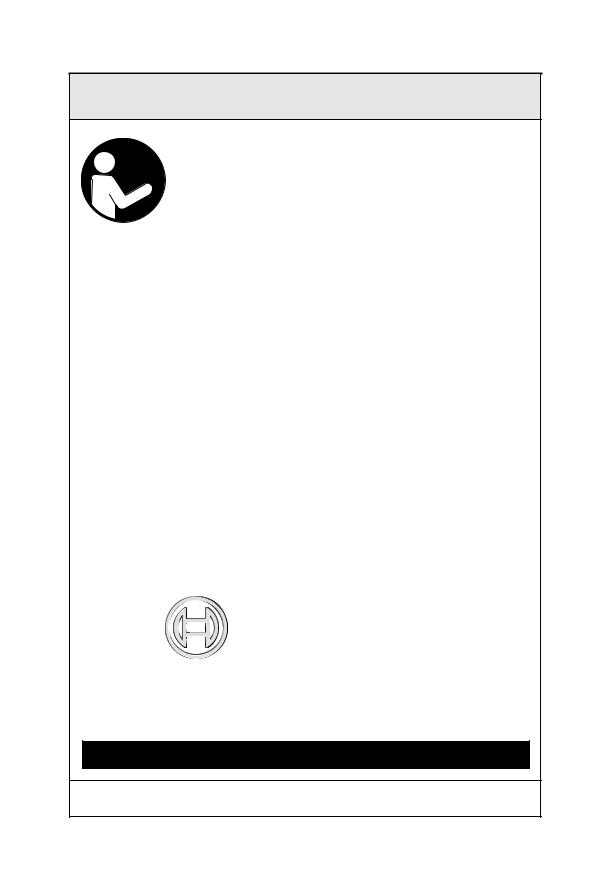
BM 2610958960 06-08 6/10/08 1:47 PM Page 1
IMPORTANT: |
IMPORTANT : |
IMPORTANTE: |
Read Before Using |
Lire avant usage |
Leer antes de usar |
Operating/Safety Instructions 
 Consignes de fonctionnement/sécurité
Consignes de fonctionnement/sécurité
Instrucciones de funcionamiento y seguridad
PS40
Call Toll Free for |
Pour obtenir des informations |
Llame gratis para |
Consumer Information |
et les adresses de nos centres |
obtener información |
& Service Locations |
de service après-vente, |
para el consumidor y |
|
appelez ce numéro gratuit |
ubicaciones de servicio |
1-877-BOSCH99 (1-877-267-2499) www.boschtools.com
For English Version |
Version française |
Versión en español |
See page 2 |
Voir page 14 |
Ver la página 26 |
|
|
|
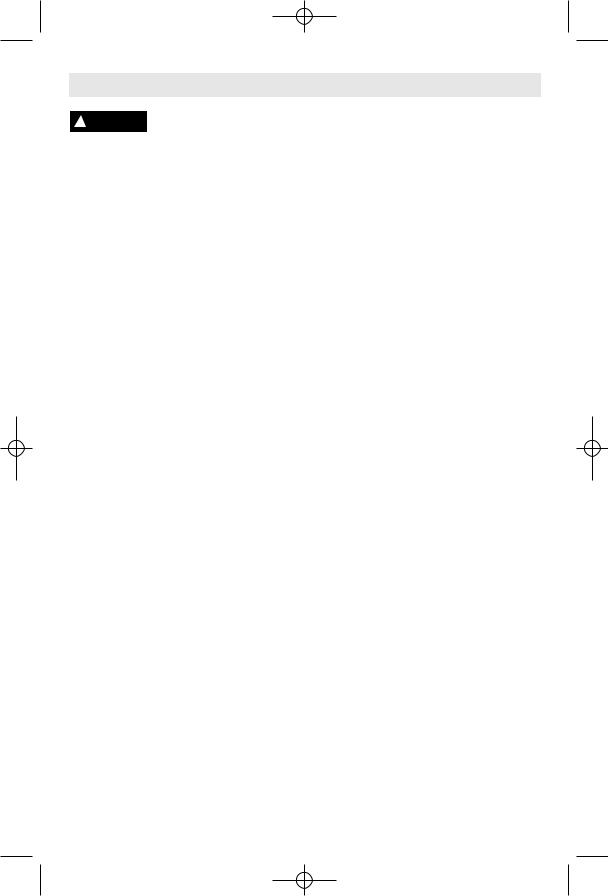
BM 2610958960 06-08 6/10/08 1:47 PM Page 2
General Safety Rules
! WARNING Read all instructions. Failure to follow all instructions listed below may result in electric shock, fire and/or serious injury. The term “power tool”
in all of the warnings listed below refers to your mains-operated (corded) power tool or battery-operated (cordless) power tool.
SAVE THESE INSTRUCTIONS
Work area safety
Keep work area clean and well lit.
Cluttered or dark areas invite accidents.
Do not operate power tools in explosive atmospheres, such as in the presence of flammable liquids, gases or dust. Power tools create sparks which may ignite the dust or fumes.
Keep children and bystanders away while operating a power tool. Distractions can cause you to lose control.
Electrical safety
Power tool plugs must match the outlet. Never modify the plug in any way. Do not use any adapter plugs with earthed (grounded) power tools. Unmodified plugs and matching outlets will reduce risk of electric shock.
Avoid body contact with earthed or grounded surfaces such as pipes, radiators, ranges and refrigerators. There is an increased risk of electric shock if your body is earthed or grounded.
Do not expose power tools to rain or wet conditions. Water entering a power tool will increase the risk of electric shock.
Do not abuse the cord. Never use the cord for carrying, pulling or unplugging the power tool. Keep cord away from heat, oil, sharp edges or moving parts. Damaged or entangled cords increase the risk of electric shock.
When operating a power tool outdoors, use an extension cord suitable for outdoor use. Use of a cord suitable for outdoor use reduces the risk of electric shock.
Do not use AC only rated tools with a DC power supply. While the tool may appear to work, the electrical components of the AC rated tool are likely to fail and create a hazard to the operator.
If operating the power tool in damp locations is unavoidable a Ground Fault Circuit Interrupter (GFCI) must be used to supply the power to your tool. GFCI and personal protection devices like electrician’s rubber gloves and footwear will further enhance your personal safety.
Personal safety
Stay alert, watch what you are doing and use common sense when operating a power tool. Do not use a power tool while you are tired or under the influence of drugs, alcohol or medication. A moment of inattention while operating power tools may result in serious personal injury.
Use safety equipment. Always wear eye protection. Safety equipment such as dust mask, non-skid safety shoes, hard hat, or hearing protection used for appropriate conditions will reduce personal injuries.
Avoid accidental starting. Ensure the switch is in the off-position before plugging in. Carrying power tools with your finger on the switch or plugging in power tools that have the switch on invites accidents.
Remove any adjusting key or wrench before turning the power tool on. A wrench or a key left attached to a rotating part of the power tool may result in personal injury.
Do not overreach. Keep proper footing and balance at all times. This enables better control of the power tool in unexpected situations.
Dress properly. Do not wear loose clothing or jewelry. Keep your hair, clothing and gloves away from moving parts. Loose clothes, jewelry or long hair can be caught in moving parts.
If devices are provided for the connection of dust extraction and collection facilities, ensure these are connected and properly used. Use of these devices can reduce dustrelated hazards.
-2-

BM 2610958960 06-08 6/10/08 1:47 PM Page 3
Keep handles dry, clean and free from oil and grease. Slippery hands cannot safely control the power tool.
Power tool use and care
Do not force the power tool. Use the correct power tool for your application.
The correct power tool will do the job better and safer at the rate for which it was designed.
Do not use the power tool if the switch does not turn it on and off. Any power tool that cannot be controlled with the switch is dangerous and must be repaired.
Disconnect the plug from the power source and/or the battery pack from the power tool before making any adjustments, changing accessories, or storing power tools. Such preventive safety measures reduce the risk of starting the power tool accidentally.
Store idle power tools out of the reach of children and do not allow persons unfamiliar with the power tool or these instructions to operate the power tool.
Power tools are dangerous in the hands of untrained users.
Maintain power tools. Check for misalignment or binding of moving parts, breakage of parts and any other condition that may affect the power tools operation. If damaged, have the power tool repaired before use. Many accidents are caused by poorly maintained power tools.
Keep cutting tools sharp and clean.
Properly maintained cutting tools with sharp cutting edges are less likely to bind and are easier to control.
Use the power tool, accessories and tool bits etc., in accordance with these instructions and in the manner intended for the particular type of power tool, taking into account the working conditions and the work to be performed.
Use of the power tool for operations different from those intended could result in a hazardous situation.
Use clamps or other practical way to secure and support the workpiece to a stable platform. Holding the work by hand or against your body is unstable and may lead to loss of control.
Battery tool use and care
Recharge only with the charger specified by the manufacturer. A charger that is suitable for one type of battery pack may create a risk of fire when used with another battery pack.
Use battery tools only with specifically designated battery packs. Use of any other battery packs may create a risk of injury and fire.
When battery pack is not in use, keep it away from other metal objects like paper clips, coins, keys, nails, screws, or other small metal objects that can make a connection from one terminal to another.
Shorting the battery terminals together may cause burns or a fire.
Under abusive conditions, liquid may be ejected from the battery, avoid contact. If contact accidentally occurs, flush with water. If liquid contacts eyes, additionally seek medical help. Liquid ejected from the battery may cause irritation or burns.
Ensure the switch is in the off position before inserting battery pack. Inserting the battery pack into power tools that have the switch on invites accidents.
Service
Have your power tool serviced by a qualified repair person using only identical replacement parts. This will ensure that the safety of the power tool is maintained.
Develop a periodic maintenance schedule for your tool. When cleaning a tool be careful not to disassemble any portion of the tool since internal wires may be misplaced or pinched or safety guard return springs may be improperly mounted. Certain cleaning agents such as gasoline, carbon tetrachloride, ammonia, etc. may damage plastic parts.
SAVE THESE INSTRUCTIONS
-3-
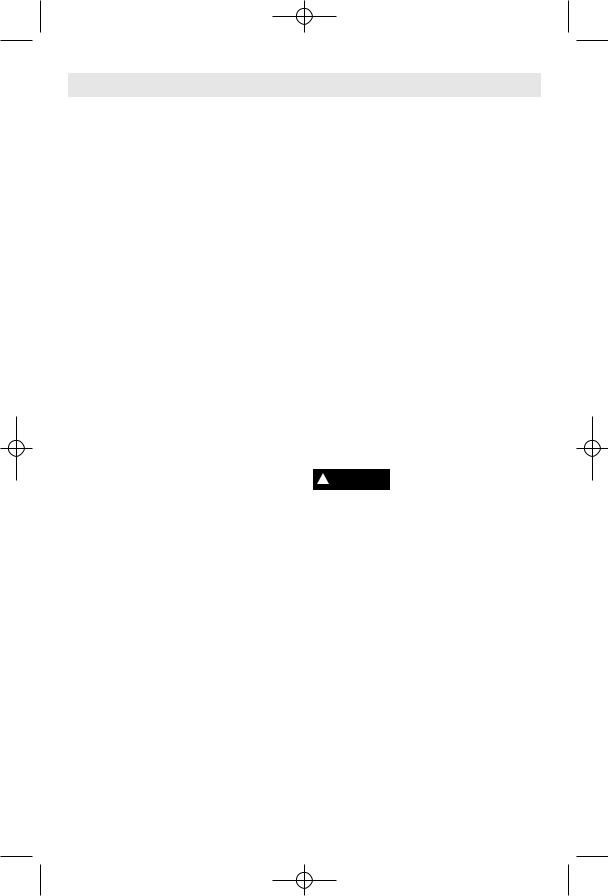
BM 2610958960 06-08 6/10/08 1:47 PM Page 4
Safety Rules for Cordless Impact Drivers
Hold tools by insulated gripping surfaces when performing an operation where the cutting tool may contact hidden wiring.
Contact with a "live" wire will make exposed metal parts of the tool "live" and shock the operator.
Use clamps or other practical way to secure and support the workpiece to a stable platform. Holding the work by hand or against your body is unstable and may lead to loss of control.
Do not drill, fasten or break into existing walls or other blind areas where electrical wiring may exist. If this situation is unavoidable, disconnect all fuses or circuit breakers feeding this worksite.
Always wear safety goggles or eye protection when using this tool.
Wear ear protectors when using the tool for extended periods. Prolonged exposure to high intensity noise can cause hearing loss.
Use thick cushioned gloves and limit the exposure time by taking frequent rest periods. Vibration caused by hammer-drill action may be harmful to your hands and arms.
Secure the material being fastened. Never hold it in your hand or across your legs.
Unstable support can cause loss of control and injury.
Avoid accidental starting. Be sure the forward/reverse switch is in the off position before inserting battery pack.
Carrying appliances with your finger on the switch or inserting the battery pack into an appliance with the switch on invites accidents.
Remove battery pack before changing accessories. Accidental starting may occur because battery appliances with a battery inserted are in the operative condition.
Be prepared for a reaction torque when “seating” or removing a fastener. The screwdriver housing may tend to twist in the opposite direction of bit rotation when
“seating” or removing a fastener depending on the torque setting of the tool.
Do not use dull or damaged bits and accessories. When installing an accessory, insert the shank of the bit well within the chuck. Be sure the chuck has locked onto the bit correctly.
Do not run the tool while carrying it at your side. A spinning bit could become entangled with clothing and injury may result.
Place the tool onto the fastener only when the screwdriver is switched off. Rotating driver tools can slide off the fastener.
Do not use this tool as a drill. Tools equipped with shut-off clutches are not designed for drilling applications. The clutch can shut off automatically and without warning.
Be careful when driving long screws – there is a risk of sliding off the fastener head depending on type of socket or bit used. First test the run-down of a fastener and pay attention during the screw driving process to ensure you do not injure yourself if the tool bit or socket slides off of the fastener.
! WARNING Some dust created by power sanding, sawing,
grinding, drilling and other construction activities contains chemicals known to cause cancer, birth defects or other reproductive harm. Some examples of these chemicals are:
•Lead from lead-based paints
•Crystalline silica from bricks, cement and other masonry products.
•Arsenic and chromium from chemically treated lumber.
Your risk from these exposures varies depending on how often you do this type of work. To reduce your exposure to these chemicals, work in a well-ventilated area and work with approved safety equipment such as dust masks designed to filter out microscopic particles.
-4-
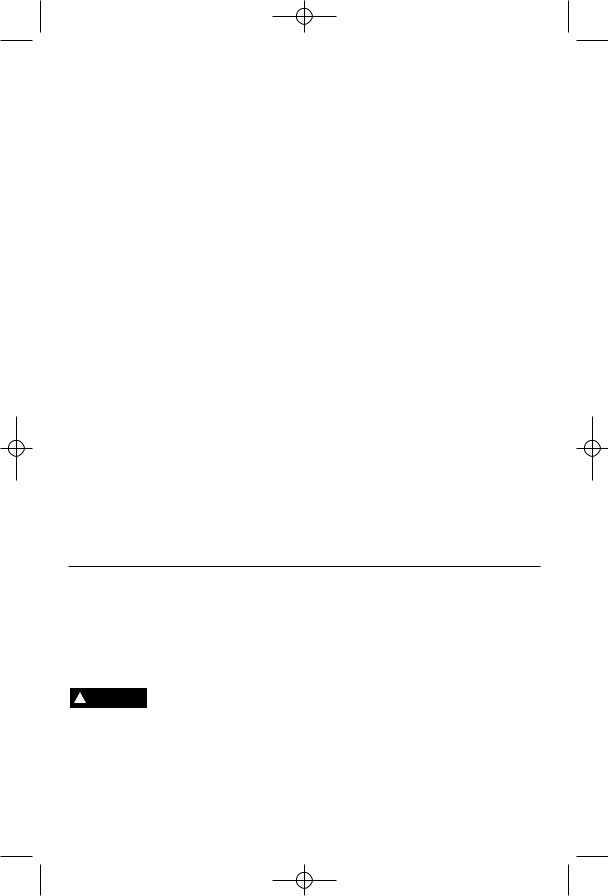
BM 2610958960 06-08 6/10/08 1:47 PM Page 5
Battery/Charger
Before using battery charger, read all instructions and cautionary markings on
(1) battery charger, (2) battery pack, and (3) product using battery.
Use only the charger which accompanied your product or direct replacement as listed in the catalog or this manual. Do not substitute any other charger. Use only Bosch approved chargers with your product. See Functional Description and Specifications.
Do not disassemble charger or operate the charger if it has received a sharp blow, been dropped or otherwise damaged in any way. Replace damaged cord or plugs immediately. Incorrect reassembly or damage may result in electric shock or fire.
Do not recharge battery in damp or wet environment. Do not expose charger to rain or snow. If battery case is cracked or otherwise damaged, do not insert into charger. Battery short or fire may result.
Charge only Bosch approved rechargeable batteries. See Functional Description and Specifications. Other types of batteries may burst causing personal injury and damage.
Charge battery pack in temperatures above +32 degrees F (0 degrees C) and below
+113 degrees F (45 degrees C). Store tool and battery pack in locations where temperatures will not exceed 120 degrees F (49 degrees C). This is important to prevent serious damage to the battery cells.
Battery leakage may occur under extreme usage or temperature conditions. Avoid contact with skin and eyes. The battery liquid is caustic and could cause chemical burns to tissues. If liquid comes in contact with skin, wash quickly with soap and water. If the liquid contacts your eyes, flush them with water for a minimum of 10 minutes and seek medical attention.
Place charger on flat non-flammable surfaces and away from flammable materials when re-charging battery pack.
The charger and battery pack heat during charging. Carpeting and other heat insulating surfaces block proper air circulation which may cause overheating of the charger and battery pack. If smoke or melting of the case are observed unplug the charger immediately and do not use the battery pack or charger.
Use of an attachment not recommended or sold by Bosch may result in a risk of fire, electric shock or injury to persons.
Battery Care
! WARNING When batteries are not in tool or charger, keep them
away from metal objects. For example, to protect terminals from shorting DO NOT place batteries in a tool box or pocket with
nails, screws, keys, etc. Fire or injury may result.
DO NOT PUT BATTERIES INTO FIRE OR EXPOSE TO HIGH HEAT. They may explode.
-5-
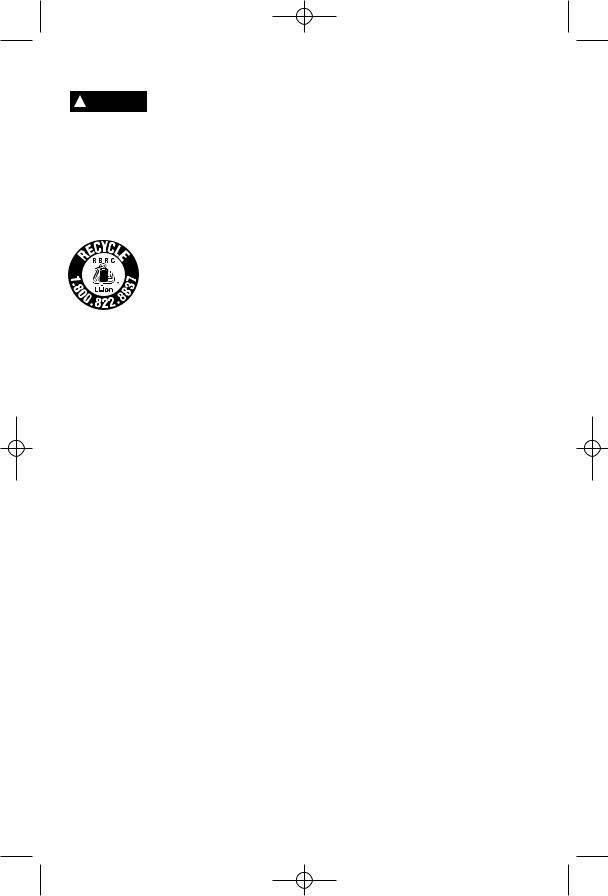
BM 2610958960 06-08 6/10/08 1:47 PM Page 6
Battery Disposal
! WARNING Do not attempt to disassemble the battery or
remove any component projecting from the battery terminals. Fire or injury may result. Prior to disposal, protect exposed terminals with heavy insulating tape to prevent shorting.
LITHIUM-ION BATTERIES
If equipped with a lithium-ion battery, the battery must be collected, recycled or disposed of in an environmentally sound manner.
“The EPA certified RBRC Battery Recycling Seal on the lithium-ion (Li-ion) battery indicates Robert Bosch Tool Corporation is voluntarily participating in an industry
program to collect and recycle these batteries at the end of their useful life, when taken out of service in the United States or Canada. The RBRC program provides a convenient alterative to placing used Li-ion batteries into the trash or the municipal waste stream, which may be illegal in your area.
Please call 1-800-8-BATTERY for information on Li-ion battery recycling and disposal bans/restrictions in your area, or return your batteries to a Skil/Bosch/Dremel Service Center for recycling. Robert Bosch Tool Corporation’s involvement in this program is part of our commitment to preserving our environment and conserving our natural resources.”
-6-

BM 2610958960 06-08 6/10/08 1:47 PM Page 7
Symbols
IMPORTANT: Some of the following symbols may be used on your tool. Please study them and learn their meaning. Proper interpretation of these symbols will allow you to operate the tool better and safer.
Symbol |
Name |
Designation/Explanation |
||||||||
|
|
|
|
V |
Volts |
Voltage (potential) |
||||
|
|
|
|
A |
Amperes |
Current |
||||
|
|
Hz |
Hertz |
Frequency (cycles per second) |
||||||
|
|
|
W |
Watt |
Power |
|||||
|
|
|
kg |
Kilograms |
Weight |
|||||
|
min |
Minutes |
Time |
|||||||
|
|
|
|
s |
Seconds |
Time |
||||
|
|
|
|
|
|
|
|
|
Diameter |
Size of drill bits, grinding wheels, etc. |
|
|
|
n0 |
No load speed |
Rotational speed, at no load |
|||||
.../min |
Revolutions or reciprocation per minute |
Revolutions, strokes, surface speed, |
||||||||
|
|
|
|
|
|
|
|
|
|
orbits etc. per minute |
0 |
|
|
|
Off position |
Zero speed, zero torque... |
|||||
1, 2, 3, ... |
Selector settings |
Speed, torque or position settings. |
||||||||
I, II, III, |
|
Higher number means greater speed |
||||||||
0 |
|
|
|
|
|
|
Infinitely variable selector with off |
Speed is increasing from 0 setting |
||
|
|
|
|
|
|
|
|
|
Arrow |
Action in the direction of arrow |
|
|
|
|
|
|
|
|
|
||
|
|
|
|
|
|
|
|
|
Alternating current |
Type or a characteristic of current |
|
|
|
|
|
|
|
|
|
Direct current |
Type or a characteristic of current |
|
|
|
|
|
|
|
|
|
||
|
|
|
|
|
|
|
|
|
Alternating or direct current |
Type or a characteristic of current |
|
|
|
|
|
|
|
|
|
||
|
|
|
|
|
|
|
|
|
Class II construction |
Designates Double Insulated |
|
|
|
|
|
|
|
|
|
||
|
|
|
|
|
|
|
|
|
|
Construction tools. |
|
|
|
|
|
|
|
|
|
|
|
|
|
|
|
|
|
|
|
|
Earthing terminal |
Grounding terminal |
|
|
|
|
|
|
|
|
|
||
|
|
|
|
|
|
|
|
|
Warning symbol |
Alerts user to warning messages |
|
|
|
|
|
|
|
|
|
||
|
|
|
|
|
|
|
|
|
||
|
|
|
|
|
|
|
|
|
Li-ion RBRC seal |
Designates Li-ion battery recycling |
|
|
|
|
|
|
|
|
|
|
program |
|
|
|
|
|
|
|
|
|
|
|
This symbol designates that this tool is listed by Underwriters Laboratories.
This symbol designates that this tool is listed by the Canadian Standards Association.
This symbol designates that this tool is listed to Canadian Standards by Underwriters Laboratories.
This symbol designates that this tool is listed by Underwriters Laboratories, and listed to Canadian Standards by Underwriters Laboratories.
This symbol designates that
this tool complies to NOM Mexican Standards.
-7-
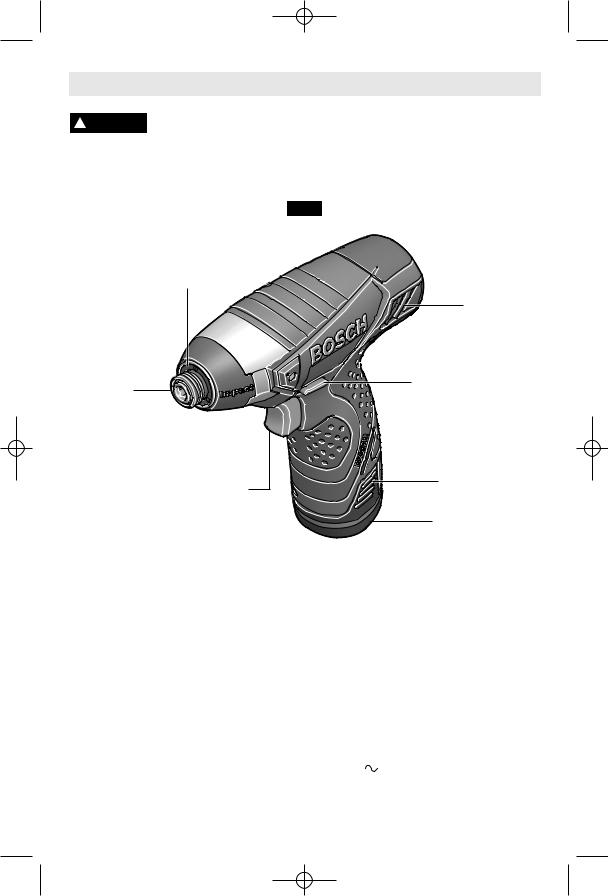
BM 2610958960 06-08 6/10/08 1:47 PM Page 8
Functional Description and Specifications
Disconnect battery pack from tool before making any assembly, ! WARNING adjustments or changing accessories. Such preventive safety measures
reduce the risk of starting the tool accidentally.
Cordless Impact Driver
LOCKING SLEEVE
FIG. 1
BUILT IN
WORK LIGHT
VENTILATION
OPENINGS
FORWARD/REVERSING
BUTTON & TRIGGER LOCK
VARIABLE SPEED |
BATTERY RELEASE |
|
TABS |
||
TRIGGER SWITCH |
||
|
||
|
BATTERY |
|
|
PACK |
Model number |
PS40 |
|
|
|
|
|
|
|
Voltage rating |
10.8V/12V |
|
|
|
|
|
MAX |
|
|
|
|||||||
|
|
|
|
|
||||
No load speed |
n0 0-1,800/min |
|
||||||
Charge time |
30 minutes |
|
||||||
Impact rate |
0-3,000 |
|
|
|
|
|
|
|
Maximum torque |
800 in-lbs |
|
|
|
|
|
|
|
Maximum Capacities |
1/4" Hex-shank with |
|||||||
Chuck size |
||||||||
|
power groove |
|
||||||
Screw Sizes |
5/16" (8 mm) |
|
||||||
Battery pack |
BAT411 |
|
|
|
|
|
|
|
Charger |
BC430 |
|
|
|
|
|
|
|
Voltage rating |
120 V |
60 Hz |
||||||
-8-
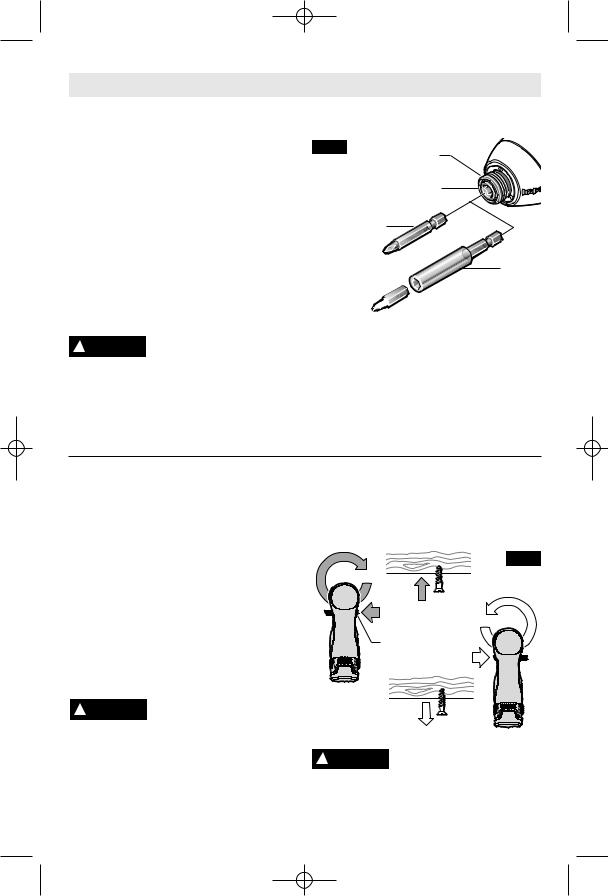
BM 2610958960 06-08 6/10/08 1:47 PM Page 9
Operating Instructions
INTENDED USE
This tool is intended for the fastening and loosening of bolts, nuts and various threaded fasteners. This tool is not intended for use as a drill.
The Bosch model PS40-2 Cordless Impact Driver has a collet that accepts only standard 1/4” hexagonal shank accessories with power groove. The low RPM capability of this model is not a deficiency. On the contrary, low speed means high torque and high torque is a definite plus for efficient drilling and driving. The low speed also provides more control to prevent stripout of the screw and damage to the work surface.
INSERTING AND REMOVING
ACCESSORIES
! WARNING To avoid loss of control, ensure bit is locked in chuck
by pulling on bit after it has been inserted.
Your tool is equipped with a quick release chuck. To insert an accessory, simply pull locking sleeve forward, insert desired accessory into chuck and release locking sleeve (Fig. 2).
To remove an accessory, pull locking sleeve forward and simply remove it from the chuck.
FIG. 2 |
LOCKING |
|
SLEEVE |
|
CHUCK |
SCREWDRIVER |
BIT |
BIT HOLDER

 SCREWDRIVER BIT
SCREWDRIVER BIT
Do not use this tool as a drill. Tools equipped with shut-off clutches are not designed for drilling applications. The clutch can shut off automatically and without warning. Attempting to restart drilling after shut-off has been reached can cause the tool to twist out of your hand until the clutch again reaches shut-off. Do not attempt to insert quick-change type drill bits into this chuck.
VARIABLE SPEED CONTROLLED
TRIGGER SWITCH
Your tool is equipped with a variable speed trigger switch. The tool can be turned "ON" or "OFF" by squeezing or releasing the trigger. The speed can be adjusted from the minimum to maximum nameplate RPM by the pressure you apply to the trigger. Apply more pressure to increase the speed and release pressure to decrease speed.
BRAKE
When the trigger switch is released it activates the brake to stop the chuck quickly. This is especially useful in the repetitive driving and removal of screws.
FORWARD/REVERSING LEVER &
TRIGGER LOCK
After tool use, lock trigger in ! WARNING “OFF” position to help prevent
accidental starts and accidental discharge.
Your tool is equipped with a forward/ reversing lever and trigger lock located above the trigger (Fig. 3). This lever was designed for changing rotation of the bit, and for locking the trigger in an “OFF” position.
For forward rotation, (with chuck pointed away from you) move the lever to the far left.
For reverse rotation move the lever to the far right. To activate trigger lock move lever to the center off position.
FIG. 3
FORWARD/ REVERSING
BUTTON & TRIGGER
LOCK
! |
CAUTION |
Do not change direction of |
|
rotation until the tool comes |
|||
|
|
to a complete stop. Shifting during rotation of the chuck can cause damage to the tool.
-9-
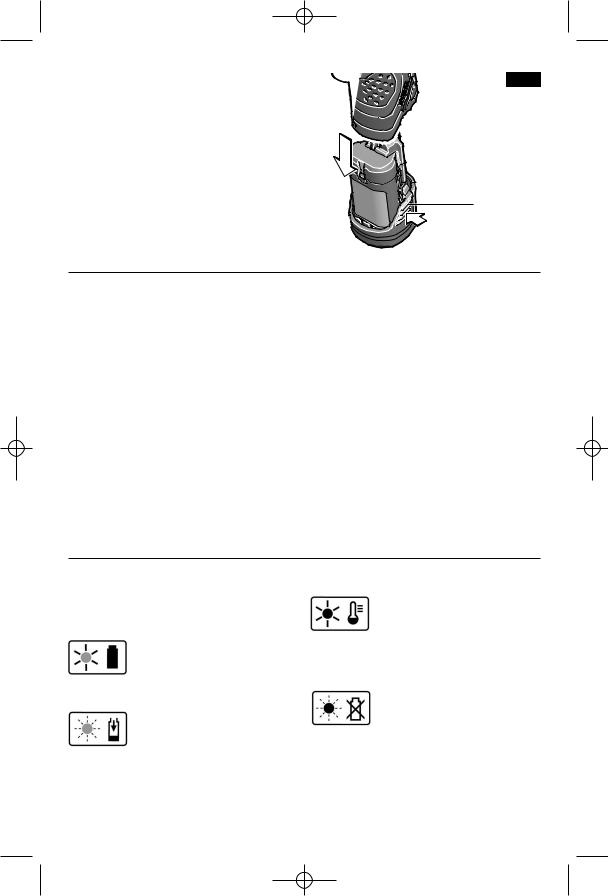
BM 2610958960 06-08 6/10/08 1:47 PM Page 10
BUILT IN WORK LIGHT
Your tool is also equipped with a light that turns on automatically when the switch is activated, for better visibility when drilling/driving (Fig. 1).
INSERTING AND RELEASING
BATTERY PACK
Release battery pack from tool by pressing on both sides of the battery release tabs and pull downward (Fig. 4).
To insert battery, align battery and slide battery pack into tool until it locks into position. Do not force.
FIG. 4
BATTERY
RELEASE TABS
IMPORTANT CHARGING NOTES
1.The charger was designed to fast charge the battery only when the battery temperature is between 32˚F (0˚C) and 113˚F (45˚C). If the battery pack is too hot or too cold, the charger will not fast charge the battery. (This may happen if the battery pack is hot from heavy use). When the battery temperature returns to between 32˚F (0˚C) and 113˚F (45˚C), the charger will automatically begin charging.
2.A substantial drop in operating time per charge may mean that the battery pack is nearing the end of its life and should be replaced.
3.Remember to unplug charger during storage period.
4.If battery does not charge properly:
a.Check for voltage at outlet by plugging in some other electrical device.
b.Check to see if outlet is connected to a light switch which turns power “off” when lights are turned off.
c.Check battery pack terminals for dirt. Clean with cotton swab and alcohol if necessary.
d.If you still do not get proper charging, take or send tool, battery pack and charger to your local Bosch Service Center. See “Tools, Electric” in the Yellow Pages for names and addresses.
Note: Use of chargers or battery packs not sold by Bosch will void the warranty.
CHARGER INDICATORS, SYMBOLS AND MEANING
If the indicator lights are “OFF”, the charger is not receiving power from power supply outlet.
If the green indicator light is “ON”, the charger is plugged in but the battery pack is not
inserted, or the battery pack is fully charged and is being trickle charged.
If the green indicator light is “BLINKING”, the battery pack is being fast-charged. Fast-
charging will automatically stop when the battery pack is fully charged.
If the red indicator light is “ON”, the battery pack is too hot or cold for fast-charging. The
charger will switch to trickle charge, until a suitable temperature is reached, at which time the charger will switch automatically to fast-charging.
If the red indicator light is “BLINKING”, the battery pack cannot accept a charge or the
contacts of the charger or battery pack are contaminated. Clean the contacts of the charger or battery pack only as directed in these operating instructions or those supplied with your tool or battery pack.
-10-
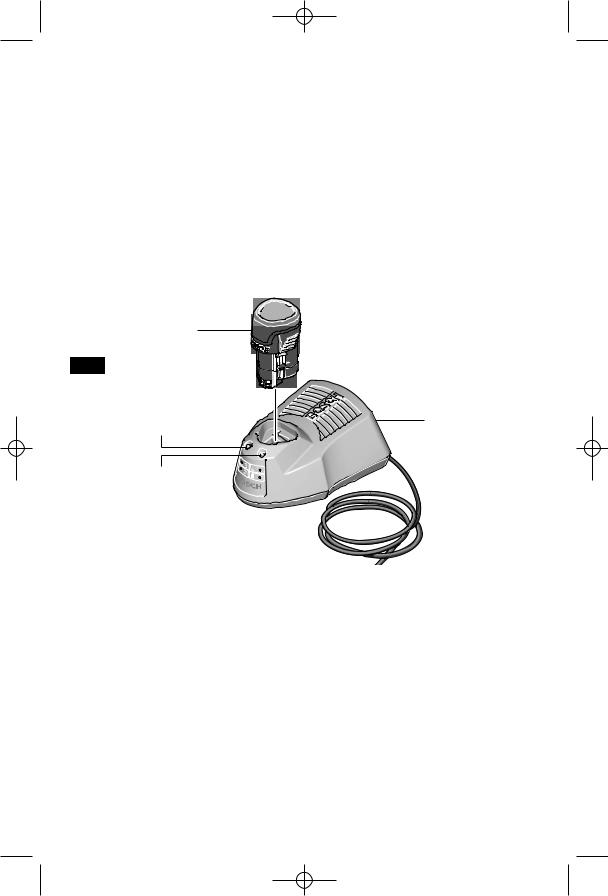
BM 2610958960 06-08 6/10/08 1:47 PM Page 11
CHARGING BATTERY PACK (BC430 30 MINUTE CHARGER)
Plug charger cord into your standard power outlet, then insert battery pack into charger (Fig. 5).
The charger’s green indicator light will begin to “BLINK”. This indicates that the battery is receiving a fast charge. Fast-charging will automatically stop when the battery pack is fully charged.
When the indicator light stops “BLINKING” (and becomes a steady green light) fast charging is complete.
The battery pack may be used even though the light may still be blinking. The light may require more time to stop blinking depending on temperature. When you begin the
charging process of the battery pack, a steady red light could also mean the battery pack is too hot or too cold.
The purpose of the green light is to indicate that the battery pack is fast-charging. It does not indicate the exact point of full charge. The light will stop blinking in less time if the battery pack was not completely discharged.
When charging several batteries in sequence, the charge time may slightly increase.
When the battery pack is fully charged, unplug the charger (unless you're charging another battery pack) and slip the battery pack back into the tool.
BATTERY
PACK
FIG. 5
CHARGER
RED LIGHT
GREEN LIGHT
Operating Tips
You will extend the life of your bits and do neater work if you always put the bit in contact with the work before pulling the trigger. During the operation, hold the tool firmly and exert light, steady pressure. Too much pressure at low speed will stall the tool. Too little pressure will keep the bit from cutting and cause excess friction by sliding over the surface. This can be damaging to both tool and bit.
DRIVING WITH VARIABLE SPEED
The technique is to start slowly, increasing the speed as the screw runs down. Set the screw snugly by slowing to a stop. Prior to driving screws, pilot and clearance holes should be drilled.
Always hold the machine straight on the bolt to be tightened.
The best method to determine the right impacting/tightening duration is by means of a trial. For small screws, the right impacting/tightening duration can be reached in less then 0.5 Sec. Therefore, work with low RPM and switch the machine off immediately when the screw is tight and the impacting sound can be heard.
For screwing larger, longer wood screws into hard material, pre-drilling is the best method.
-11-
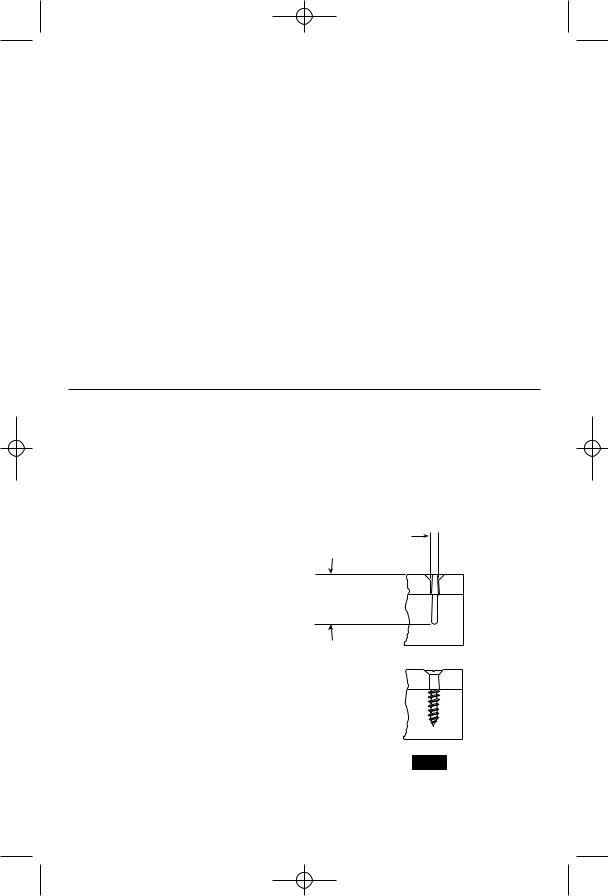
BM 2610958960 06-08 6/10/08 1:47 PM Page 12
TIGHTENING TORQUE
The tightening torque depends on the duration of the impacting/tightening action. The largest tightening torque is achieved after approx. 6 to 10 Sec. impacting/tightening action.
The torque build-up depends on the following factors:
•Hardness of the bolts/nuts.
•Type of washer (disk washer, spring washer, seal).
•Hardness of the material to be joined.
•Lubricating effect at the surfaces of the junction.
This leads to the following application cases:
Hard case: The joining of metal to metal with a disk washer. The maximum torque is reached after a relative short impacting/ tightening action.
Medium case: The joining of metal to metal where spring ring washer, disk spring washer, stud bolts or bolts/nuts with conical seats are used.
Soft case: The joining of e.g. metal to wood or insulation material.
For middle or soft joining cases, the maximum tightening torque is less as for hard cases. Therefore, a longer impacting/tightening action is necessary to arrive at the maximum tightening torque.
FASTENING WITH SCREWS
This procedure shown in (Fig. 6) will enable you to fasten materials together with your tool without stripping, splitting or separating the material.
First, clamp the pieces together and drill the first hole 2/3 the diameter of the screw. If the material is soft, drill only 2/3 the proper length. If it is hard, drill the entire length.
Second, unclamp the pieces and drill the second hole the same diameter as the screw shank in the first or top piece of wood.
Third, if flat head screw is used, countersink the hole to make the screw flush with the surface. Then, simply apply even pressure when driving the screw. The screw shank clearance hole in the first piece allows the screw head to pull the pieces tightly together.
RUNNING NUTS AND BOLTS
Variable speed control must be used with caution for driving nuts and bolts with socket set attachments. The technique is to start slowly, increasing speed as the nut or bolt runs
down. Set the nut or bolt snugly by slowing the tool to a stop. If this procedure is not followed, the tool will have a tendency to torque or twist in your hands when the nut or bolt seats.
FASTENING WITH SCREWS
1.Drill 2/3 diameter and 2/3 of screw length for soft materials, full length for hard materials.
 2. Drill same diameter as screw shank.
2. Drill same diameter as screw shank.
 3. Countersink same diameter as screw head.
3. Countersink same diameter as screw head.
 Screw
Screw
Apply a slight even pressure when driving screws.
FIG. 6
-12-
